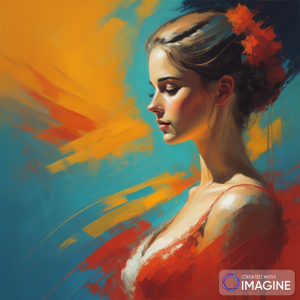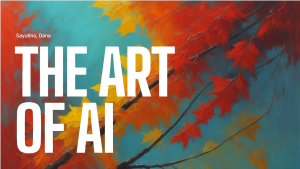3 ART-ificial Intelligence: The Art of AI Art
Sayutina Dana

Image created with imagine.art
Prompt: AI
Introduction
The future is nigh, welcome. Humanity has reached a point where cars can drive themselves and robots can paint. May the great masters rest in peace as AI completes in seconds what often took them years to master.
This new world, though intimidating, can do things for you that you couldn’t even begin to imagine.
Generative AI, specific to art, can be used in many different ways, which is what this chapter will explain more thoroughly. It will use Imagine.art as the specific example, to discuss how text-image-AI, in the hands of a teacher, can be a useful tool.
Connection to Curriculum
How does the tool connect to the curriculum you ask? Well, lets look first at the cross-curricular competencies.
Generative AI connects to all the competencies by being a platform through which students can develop thinking, literacy, and social responsibility. It can aid in building a deeper understanding of the world, another context for students to learn within and critically analyze. Exploration, experimentation, creation, amongst others are all areas within which AI can be a tool for students. Generative AI is a literacy if nothing else, it provides a means for expression of the world, another means to interpret the world. Students may use it as a means to create meaning, to communicate. Within all this the student inevitably develops an integrity with using AI, a social responsibility, because AI is something that will only continue to evolve and we must learn to adapt with it.
Narrowing the focus to the Art Ed Curriculum, as it states the “aim of kindergarten to Grade 12 Arts Education is to enable students to understand and value arts expressions throughout life.” AI can be used as a tool to aid in reaching this objective.
So, can generative AI fit into any Art Ed outcomes? Lets see some examples.
CP30.1 – Creating work in selected art disciplines individually and/or collaboratively. Check.
CP10/20/30.2 – Multidisciplinary arts expression, individually or collaboratively. Check.
CP10/20/30.3 – Experimenting and communicating in new ways through the arts. Check.
CP10/20/30.4 – Experimenting with personal preferences, media, and styles in developing an artistic voice. Check.
While we can go on, you get the idea that there are more than many ways that AI can fit into the Arts Ed Curriculum.
This new and emerging technology will open up the floor to many new conversations with students but the sooner we accept and begin using it as a tool, no different than a paintbrush or adobe photoshop, the sooner we can explore and learn within this new discipline.
Affordances and Constraints
As AI becomes more and more common the affordances and constraints associated with it will change. As we’ve already seen, as the popularity rose so did the new requirements to sign up and pay for AI. More and more limitations are being introduced as time goes on, now even some of the platforms that are still free to use are limited to only 20 generative images in 24-hour periods. That being said, there are ways around it, there are ways to work with it, if anything the restrictions make it more interesting.
As we adapt and learn to accommodate for new AI tools, especially in the domain of education, there will also emerge accommodations for us as teachers and for our students because there’s no denying the use of AI.
The Process
Every AI is unique in its own way but roughly the same idea, like crayons in a box. It doesn’t take long to learn and once you do you’ll have the hang of them all. What you’ll look for in text-to-image generators like imagine.art is a chat bar.
From there, the world is your oyster. The best way I have found to learn about AI is through trial and error, there is no right or wrong (even robots can learn, there’s hope for us yet). Sometimes, there are image-to-image generators and in imagine.art’s case there is quite a new feature called “image remix” that looks like the second icon here, found in the menu above the images you generate:
The feature is exactly what is sounds like, you upload am image, enter a prompt, and it remixes the image based on what you’ve offered.
Different AI’s will all have their different quirks, the point is that they’re all relatively user friendly and quickly evolving. What is relevant to AI right may not be in a little while. Nonetheless, the only way is forward.
Prompt Engineering
The best advice when it comes to prompts, especially with images is to keep your prompts clear because sometimes it simply won’t recognize overcomplicated words. The sweet spot (they say) is 3 to 7 words and through my experience the more words you have the more gets lost.
Specifically, with imagine.art if you input too many words in your prompt it will focus on a couple primarily and you won’t recognize the other suggestions, even with multiple generations.
The rule of thumb with text-to-image generators, to yield the best results, would be to describe as concisely as you can the image, style and any particular features you’re looking for. If there are features you specifically don’t want, there is a “negative prompts” chat box you can type them in.
Recommendations
How to Use Imagine AI Art Generator by Explain Me on youtube
Informative presentation
Acknowledgement of AI Use
I used Imagine.art to create all the themed art throughout the chapter and pitch.com to help with the presentation template. It was my first time using the new AI presentation platform.
